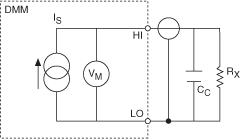System Considerations for Resistance Measurements
When measuring resistance in a system, it is important to consider the effects of cable resistance. It is also important to notice that interactions between scanning multiple resistances and system cabling can present time-dependent problems. These problems can be avoided by following these simple guidelines.
- As you scan from channel to channel, the current source must drive the voltage across the resistor to a quiescent level before a meaningful measurement can be made. If there is substantial system capacitance, this capacitance must also be charged by the current source. Starting the measurement before the capacitance is fully charged results in an erroneous measurement. For more information, refer to Settling Time.
- Resistance measurements up to 10 kΩ seldom encounter settling time problems, as long as the system capacitance is <500 pF and you allow a settling time of 2 ms or more.
- Settling time might need to be longer if significant dielectric absorption effects are present in the cables and switching system. Resistance values above 100 kΩ are most sensitive to cable capacitance and other dielectric effects. If dielectric absorption is suspect, find the optimum setting experimentally by increasing the settling time until the readings no longer change.
The following figure illustrates the factors affecting settling time for a resistance measurement:

Settling Time = kCCRX
where
k = the value related to accuracy required, refer to Settling Time
CC = the capacitance of the cable and switching network
RX = the resistance being measured
 |
Note Remember that if you measure 100 Ω on the 1 MΩ range, the settling time is a function of the measured resistance of 100 Ω, not 1 MΩ. |
Refer to DMM Measurement Cycle for more information on settling time. Remember that the Offset Compensated Ohms function toggles the current source on and off. Excessive system capacitance due to cables, in circuit elements, and so on may affect this measurement as it affects it in a scanning system. The Belden 83317E cable has a capacitance of 35.5 pF/ft and extremely low dielectric absorption. Refer to the Belden CDT Incorporated Web site at www.belden.com for information about this cable.